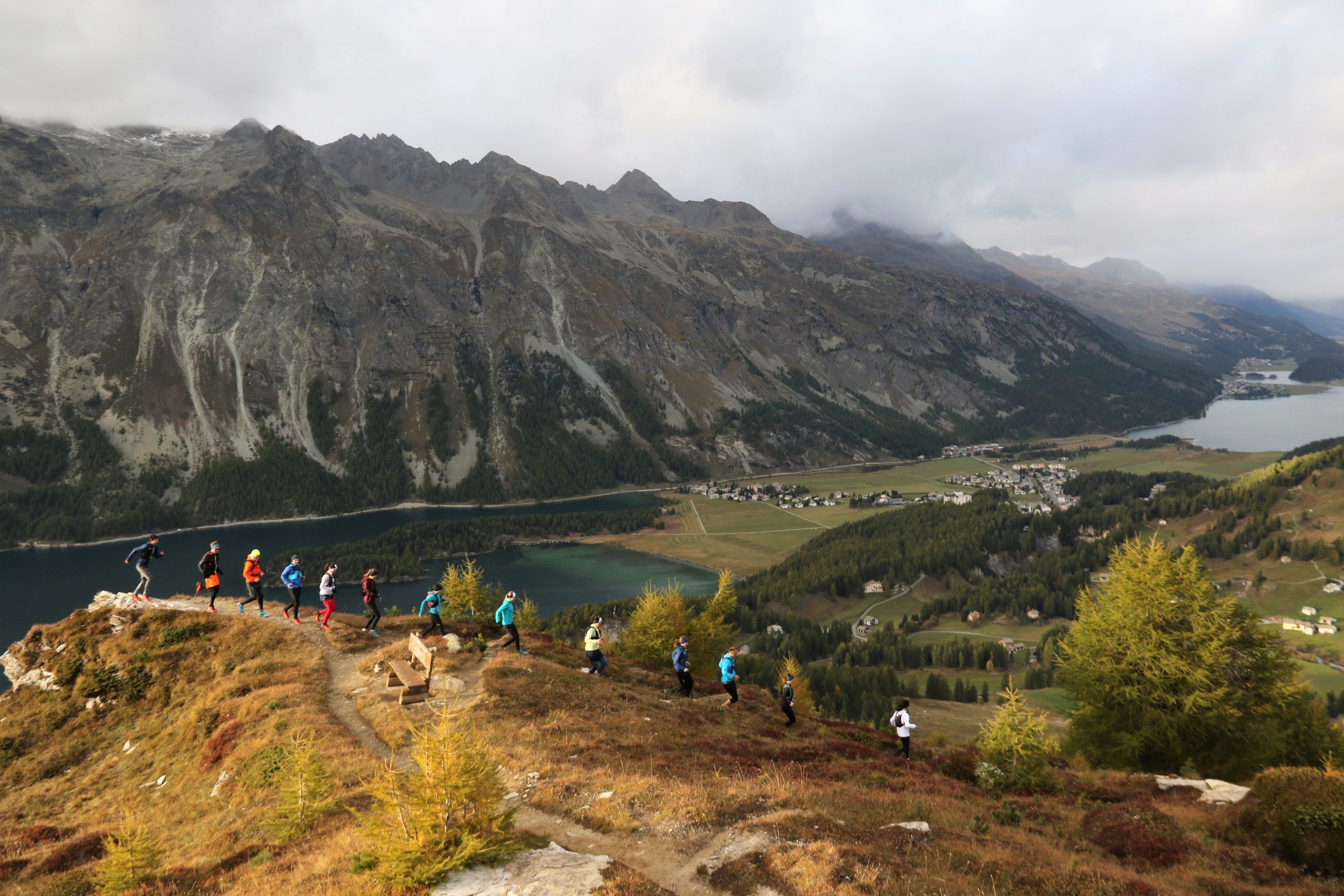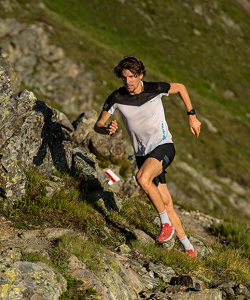The sun is high above the horizon and warms the asphalt of the road so that the heat not only hits the body directly but also indirectly. Running during the summer months has many advantages – but the aspect mentioned above is more of a disadvantage. Trail running is a good way to escape the glistening asphalt, get a breath of fresh mountain or forest air and enjoy breathtaking views at the same time.
Why Trail Running?
Trail running has many positive aspects to offer – not least in warm temperatures. Because trail running starts where the asphalt stops, which means that the runs are often done in the forest or in the mountains, where temperatures are usually a bit more moderate. Depending on the route chosen, the technical challenge is also different. The comparability of different routes is minimal, which dampens the inner urge to run fast mileage and lets you enjoy the run.
But it is not only the pleasure-seekers who get their money’s worth with trail running. The movement off the beaten track also has a positive effect on strength, endurance and coordination, which can also benefit from road running (more about this here).
Technique
An important aspect of trail running is the technique. A high anaerobic threshold is of little use if the limiting factors are the roots and stones that make fast running difficult.
It is important to look ahead in order to be able to recognize possible obstacles at an early stage, but at the same time not to lose sight of the place of the next footprint. A constant back and forth, which needs to be practiced.
An active running style and an increased level of concentration are therefore required. More tips on technique can be found here.
Planning / navigating routes

Before we start, it is important to plan the routes. In doing so, the following must be taken into account: Distance, altitude difference up and down, difficulty, or runnability of the trails. A further advantage is to plan for shortcuts and, if necessary, extensions. Available water replenishment possibilities such as fountains, alpine businesses, farms or restaurants should also be included in the planning.
Important for the planning: comfortable trail runners cover about 500 metres of altitude per hour, fast runners rather 1000 metres. Running downhill on technical trails can also be very demanding and take more time than you think.
There are various tools and websites for planning the routes, some of them for a fee, some of them free of charge:
- Schweizmobil Plus (https://www.schweizmobil.ch/, only for trails in Switzerland)
- Strava (http://strava.com/)
- Outdoor Active (https://www.outdooractive.com/)
- AllTrails (https://www.alltrails.com/)
- Komoot (https://www.komoot.com/)
- FATMAP (https://www.fatmap.com)
- Suunto Movescount (http://www.movescount.com/)
Navigation
Navigating in unknown terrain needs practice. The more you use a map, the more likely it is that you will be able to identify distances, trail difficulty and altitude to be covered easily from the map. To practice this we recommend to use paper maps whenever possible.
For help and as a backup a map app on your mobile phone is highly recommended. The planned route can also be saved on it and with the help of the current GPS position you can see where you are in case you are ‘lost’ (the location based on your mobile phone position should be used with caution).
All today’s GPS watches offer navigation functions besides tracking the route you have taken. So the planned route can be loaded onto the watch and followed. With the newest models even map data is stored.
By the way, for all those who like to improve their map reading skills a little: We can recommend a visit to an adult orienteering course at an orienteering club in your region (list of all Swiss orienteering clubs) and whenever possible try to navigate yourself on the tours using a paper map (and without GPS navigation).
Proper equipment
The right equipment is essential for trail running on longer tours. First and foremost, the equipment should be functional and light, but it should also provide safety and be sufficient in emergencies.
- Shoes: The choice of the right trail running shoe is very individual. Important: a good running shoe can be bought in specialist shops (e.g. at Ochsner Sport). Depending on the terrain, the perfect shoe should meet different requirements and give a good feeling. In the terrain you should feel like a mountain goat and not like a tractor. The shoe should therefore be more direct and have a good nubbed profile. It is important to have a toe cap so that even a step into a stone or root does not hurt too much.
- A road running shoe does not belong in the mountains, even in dry conditions.
- Drinking backpack/vest: Drinking vests and backpacks are so well made these days that you can hardly feel them. In most of the common models the so-called flasks are provided as drinking system, which are usually included in the standard package. The Flasks are mounted on the shoulder straps at chest height and allow easy and regular drinking. Filling up is also very easy. The front pockets can also be used to store the most important other material and snacks and are accessible without having to take off the vest! By the way: there are also special drinking vests for women.
- Map material: For all trail running routes in unknown terrain a printed map and for inexperienced map readers a mobile phone map app with topo maps (also available offline) and current location is a must.
Our further packing tips:
- Rain or wind jacket: In stable conditions a light jacket that protects against wind is sufficient. In case of possible precipitation, a rainproof jacket is a must.
- Drinks: In the mountains there is usually a wonderful flow of glacier or mountain water. Often there are also alps and farms where water can be drunk from a well or filled up. Depending on your taste you can also carry isotonic powder. As a rule of thumb, 0.5l of liquid per hour is a good drinking quantity. At hot temperatures correspondingly more.
- Nutrition: Sufficiently easily digestible snacks such as bars, dried fruit and similar. A little salt in case of cramps.
- Mobile phone: The mobile phone is compulsory in any case. It can (hopefully with reception) also inform family members about a later return home or in case of an emergency also alert the air rescue service. Important: save emergency numbers and possibly also install a rescue app (e.g. for Switzerland Rega-App) Also the Weather App (e.g. Meteoschweiz) and anyway the SBB App for all means of public transport.
And, of course, we also want to take a photo of the most beautiful trails, the view from the top of the mountain or my dirty shoes. (-> Instagram also needs content) - Small first aid kit with important contents: wound disinfectant, bandages, rescue blanket, phyiostape
- cash/credit cards for coffee stops, shortcuts by train or similar
- Sun protection: In the mountains, the sun is very strong and you are often very exposed. A running cap is therefore an advantage, sun protection is a must!
- Poles: For longer tours it is worth taking folding poles with you. These can relieve the thighs in steep uphill sections. The upper body muscles can also be trained in this way. On steep downhill sections the poles can also help to reduce the strain on the braking muscles. However, running downhill quickly with poles and an active use of the arms when running uphill must be trained.
Depending on the temperature and altitude, it is also a good idea to pack a thermoshirt and even gloves and a cap.
Experience and learn trail running together
The best thing about trail running is to share your experiences and discover areas that are still unknown. Together with trailrunning professional athlete Judith Wyder, we offer trailrunning courses with indurance (www.indurance.ch), where learning the technique on the small trails and the shared experience of running in nature and fun in a group are very important.
Highly recommended are the trail running days in the Engadin from 14 – 20 October 2021. to run in the Engadin in autumn with its blaze of colour is a great experience. More information: https://www.indurance.ch/trailrunningtage-engadin/

Trail Running Competitions 2020
In the current situation with COVID-19, all major events are cancelled. Especially in trail running, where you are often not in the big crowd, competitions are possible and are often held by organizers. Here are some examples of trail running competitions.
All course data and information about the competitions can also be found in the running.COACH running calendar. And if you would like to know how long it will take you to complete a course, you can also use the running.COACH prediction calculator to calculate your target time and mileage based on a past race.
Switzerland
- 21./22.8.20 Matterhorn Ultraks
- 26.8.20 TrailRun Bern, Gurten
- 29.8.20 Trail du Besso, Zinal
- 29.8.20 Niederhorn Berglauf, Beatenberg
- 30.8.20 Madrisa Trail
- 1.9.20 Swiss Peak Trail
- 5.9.20 Grächen Berglauf, Grächen
- 9.9.20 TrailRun Bern, Lisiberg
- 12.9.20 Arosa Trailrun
- 18.-20.9.20 Swiss Trail Tour, Lenk
- 19.9.20 Trail des Dents du Midi, Champéry
- 7.10.20 TrailRun Bern, Ulmiz
- 25.10.20 Gantrisch Trail, Riggisberg
- 12.12.20 Trail des Châteaux, Sion
Germany
Austria
Note: The list is not complete. We would be grateful for any information about other trail running events that will definitely be held this year!


